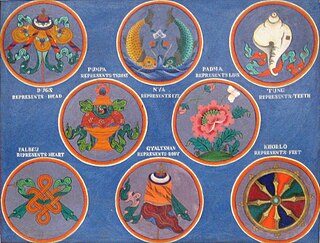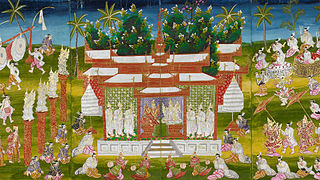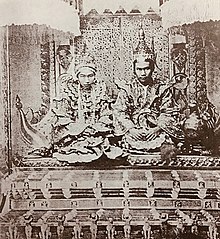
Vamana, also known as Trivikrama, Urukrama (transl. far-stepping), Upendra, Dadhivamana, and Balibandhana, is an avatar of the Hindu deity Vishnu. He is the fifth avatar of Vishnu, and the first Dashavatara in the Treta Yuga, after Narasimha.
Since the death of the historical Buddha, Siddhartha Gautama, Buddhist monastic communities ("sangha") have periodically convened to settle doctrinal and disciplinary disputes and to revise and correct the contents of the Buddhist canons. These gatherings are often termed Buddhist "councils". Accounts of these councils are recorded in Buddhist texts as having begun immediately following the death of the Buddha and have continued into the modern era.

The Konbaung dynasty, also known as Third Burmese Empire (တတိယမြန်မာနိုင်ငံတော်), was the last dynasty that ruled Burma/Myanmar from 1752 to 1885. It created the second-largest empire in Burmese history and continued the administrative reforms begun by the Toungoo dynasty, laying the foundations of the modern state of Burma. The reforms, however, proved insufficient to stem the advance of the British, who defeated the Burmese in all three Anglo-Burmese Wars over a six-decade span (1824–1885) and ended the millennium-old Burmese monarchy in 1885. Pretenders to the dynasty claim descent from Myat Phaya Lat, one of Thibaw's daughters.
Priests of the Vedic religion are officiants of the yajna service. Yajna is an important part of Hinduism, especially the Vedas. Persons trained for the ritual and proficient in its practice were called ṛtvij. As members of a social class, they were generically known as vipra 'sage' or kavi 'seer'. Specialization of roles attended the elaboration and development of the ritual corpus over time. Eventually a full complement of sixteen ṛtvijas became the custom for major ceremonies. The sixteen consisted of four chief priests and their assistants.

The Ashtamangala is a sacred suite of Eight Auspicious Signs featured in a number of Indian religions such as Hinduism, Jainism, and Buddhism. The symbols or "symbolic attributes" are yidam and teaching tools. Not only do these attributes point to qualities of enlightened mindstream, but they are the investiture that ornaments these enlightened "qualities". Many cultural enumerations and variations of the Ashtamangala are extant.

Purohita, in the Hindu context, means chaplain or family priest within the Vedic priesthood. In Thailand and Cambodia, it refers to the royal chaplains.

Chandi or Chandika is a Hindu deity. Chandika is another form of Mahadevi, similar to Durga. Chandika is a powerful form of Mahadevi who manifested to destroy evil. She is also known as Kaushiki, Katyayani, AsthadasabujaMahalakshmi and Mahishasuramardini.

Buddhism, specifically Theravāda Buddhism, is the state religion of Myanmar since 1961, and practiced by nearly 90% of the population. It is the most religious Buddhist country in terms of the proportion of monks in the population and proportion of income spent on religion. Adherents are most likely found among the dominant Bamar people, Shan, Rakhine, Mon, Karen, and Chinese who are well integrated into Burmese society. Monks, collectively known as the sangha (community), are venerated members of Burmese society. Among many ethnic groups in Myanmar, including the Bamar and Shan, Theravada Buddhism is practiced in conjunction with the worship of nats, which are spirits who can intercede in worldly affairs.

Thingyan is the Myanmar New Year festival that usually occurs in middle of April. It is a Buddhist festival celebrated over a period of four to five days, culminating in the New Year. The dates of the Thingyan Festival are calculated according to the Burmese calendar. The dates of the festival are observed as public holidays throughout Myanmar, and are part of the summer holidays at the end of the school year. Water-throwing or dousing one another from any shape or form of vessel or device that delivers water is the distinguishing feature of this festival and may be done on the first four days of the festival. The New Year takes place at virtually the same time as the new year celebrations of many countries in South Asia like China, Laos, Thailand, Cambodia, Nepal, Bangladesh, India, and Sri Lanka.
Jain rituals play an everyday part in Jainism. Rituals take place daily or more often. Rituals include obligations followed by Jains and various forms of idol worship.
Paritta (Pali), generally translated as "protection" or "safeguard," refers to the Buddhist practice of reciting certain verses and scriptures in order to ward off misfortune or danger, as well as to the specific verses and discourses recited as paritta texts. The practice of reciting or listening to the paritta suttas began very early in the history of Buddhism.

A kyaung is a monastery (vihara), comprising the domestic quarters and workplaces of Buddhist monks. Burmese kyaungs are sometimes also occupied by novice monks (samanera), lay attendants (kappiya), nuns (thilashin), and young acolytes observing the five precepts.
M. Feraud was a French diplomat of the 18th century who went on a mission to resume official French East India Company contacts with Burma in 1769. He obtained a trade treaty, and the establishment of a French factory in the city of Rangoon.

Napoleon and Joséphine were crowned Emperor and Empress of the French on Sunday, December 2, 1804, at Notre-Dame de Paris in Paris. It marked "the instantiation of [the] modern empire" and was a "transparently masterminded piece of modern propaganda".
Coronations in Asia in the strict sense are and historically were rare, as only few monarchies, primarily in Western Asia, ever adopted the concept that the placement of a crown symbolised the monarch's investiture. Instead, most monarchies in Asia used a form of acclamation or enthronement ceremony, in which the monarch formally ascends to the throne, and may be presented with certain regalia, and may receive homage from his or her subjects. This article covers both coronations and enthronement.

The Sinhalese monarchy has its origins in the settlement of North Indian Indo-Aryan immigrants to the island of Sri Lanka. The Landing of Vijay as described in the traditional chronicles of the island, the Dipavamsa, Mahavamsa and Culavamsa, and later chronicles, recount the date of the establishment of the first Sinhala Kingdom in 543 BC when Prince Vijaya, an Indian Prince, and 700 of his followers are claimed to have landed on the island of Sri Lanka and established the Kingdom of Tambapanni. In Sinhalese mythology, Prince Vijaya and followers are told to be the progenitors of the Sinhalese people. However according to the story in the Divyavadana, the immigrants were probably not led by a scion of a royal house in India, as told in the romantic legend, but rather may have been groups of adventurous and pioneering merchants exploring new lands.
The coronation of the monarch of Thailand is a ceremony in which they are formally consecrated by anointment and crowning. The ceremony is divided into two main events: the coronation rites and the celebration of the Assumption of the Residence. The coronation rites are a blend of Hindu and Buddhist traditions dating back several centuries. The rites included the purification bath of the king, the anointing of the king, the crowning of the king, and the investiture of the royal regalia, the royal utensils, and the royal weapons of sovereignty. The Assumption of the Residence is a private housewarming celebration by members of the royal family at the Grand Palace.
Weddings in Myanmar, considered auspicious occasions in Burmese culture, reflect various ethnic, religious, and regional traditions. Depending on an individual's family social economic status, personal preferences and titles held, Burmese weddings can be religious or secular, and extravagant or simple. Wedding expenses are covered by the groom's family. Myanmar is a predominantly Buddhist country, and many wedding customs and traditions are influenced by Buddhism.

The coronation of Vajiralongkorn (Rama X) as king of Thailand took place on 4 May 2019 at the Grand Palace, Bangkok. He ascended the throne at the age of 64 upon the death of his father, Bhumibol Adulyadej, on 13 October 2016, accepting the accession invitation by Prem Tinsulanonda, president of the Privy Council, on 1 December 2016. The coronation was held within just three years after his accession to the throne in 2016 because of an appropriate length of time to pass after the death and funeral of Bhumibol Adulyadej and the arrangement of the ceremony after the last such rite having been held in 1950.

The coronation (Rajabhiseka) of Mindon Min and Setkya Dewi as king and queen of the Konbaung Kingdom took place at Mandalay Palace on 14 May 1857.















